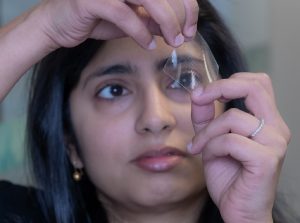New device mimics body’s feedback response
This article is suitable for Yr 9 and 10 biology students learning about the artificial skin and the role of engineering in biotechnology.
Word Count: 906

Researchers at Australia’s RMIT University have developed prototype electronic artificial skin that senses and reacts to pain just like human skin.
The device mimics the body’s near-instant feedback response; it can react to painful sensations with the same speed that nerve signals are transmitted to the brain.
Research leader Madhu Bhaskaran says the pain-sensing prototype is a significant advance towards next-generation biomedical technologies and intelligent robotics.
“Skin is our body’s largest sensory organ, with complex features designed to send rapid-fire warning signals when anything hurts,” she says. “We’re sensing things all the time through the skin but our pain response only kicks in at a certain point, like when we touch something too hot or too sharp.
“No electronic technologies have been able to realistically mimic that very human feeling of pain – until now.”
The electronic skin research – published in the journal Advanced Intelligent Systems and filed as a provisional patent – combines three technologies previously pioneered and patented by Bhaskaran’s team:
- stretchable electronics, which combine oxide materials with biocompatible silicon to deliver transparent, unbreakable and wearable electronics as thin as a sticker
- self-modifying coatings 1000 times thinner than a human hair, based on a material that transforms in response to heat
- and electronic memory cells that imitate the way the brain uses long-term memory to recall and retain previous information.
Bhaskaran explains that stretchable electronics with skin-like properties have been developed to make sensors that monitor health and environment. Applications include monitoring UV exposure on skin, detecting the presence of dangerous gases (pollution, toxic gases, cigarette smoke), and measuring biomarkers related to health and nutrition.
The artificial skin incorporates three different sensor types – for touch, temperature and pain – in soft electronics with brain-mimicking electronics that control thresholds (detection levels).

Underlying the technology’s development are drives to support people with skin damage from burns or grafts; to improve prosthetic interfaces, for instance by enhancing an artificial limb’s ability to precisely grip and to sense sources of damage; and to enhance the sensitivity of human skin to make smart gloves – ones that would give surgeons improved touch, among other applications.
With so much human ingenuity devoted to relieving pain, it’s unusual to learn of technological developments that focus on replicating pain-sensing.
“The reason we want to replicate pain is to make components and devices that show a response similar to the human body,” says Bhaskaran. “For example, a person with a prosthetic arm made with metal might place it with pressure against a sharp surface and damage it.
“As there are no pain receptors, they do not realise the damage they are inflicting. A realistic skin-like response can make the prosthetic more like a natural limb.”
Perhaps the most interesting component of electronic skin is its self-modifying coating, made from vanadium dioxide. When exposed to heat, the material changes crystal – structure – and transforms from an electrical insulator (blocking current) to an electrical conductor (it becomes like a wire).
“This self-modification is a natural and reversible process, as once the heat is removed the material rearranges its crystal back to its original state,” says Bhaskaran. “This technology and material have energy applications, as it also blocks all infrared radiation, enabling smart window technology for energy-efficient buildings.”
Stretchable electronics is a rapidly advancing field with many research teams around the world – including in the US, UK, Korea and Singapore – developing technology that’s the basis of many smart patches and sensors for health and wellbeing.

The RMIT team’s breakthough has been essentially creating the first electronic somatosensors – replicating the key features of the body’s complex system of neurons, neural pathways and receptors that drive our perception of sensory stimuli such as touch, pressure, pain and temperature.
Bhaskaran says there have been “a handful of examples” of artificial somatosensors made by other research teams.
“However, in all these cases, the stimuli (pressure, temperature or pain) have been ‘simulated’ – real stimuli were not applied but an electrical signal equivalent to them was applied as input,” she says. “Moreover, we do not know of any case where all somatosensory elements were integrated into one system.”
Such sensory-system integration would be critical for one of the technology’s main uses, as electronic artificial skin on prosthetics that mimics the sensitivity and stimulus response time of natural skin.
Existing technology is used to “wire” many prosthetic components to the human central nervous system; such technology will be used to transfer electrical signals from artificial skin into the neural system.
Another application with intriguing possibilities is electronic skin’s use as an alternative to skin grafts, for instance for burn victims. Bhaskaran says that if a patient hasn’t experienced long-term damage from their injuries, electronic skin could be a temporary solution until the real skin grows back – but with the patient retaining sensitivity and reasonable functionality during their convalesence.
As permanent skin replacement, she says the technology would need validation of its properties for biocompatibility and lifetime and robust performance.
Because electronic skin is a development of technologies already patented by Bhaskaran’s team, its real-world use might not be too far away.
“The immediate next steps would be the realisation of a completely stretchable and skin-like platform – this is achievable within a year,” says Bhaskaran.
“We would also look forward to working with medical researchers and industry to enhance our understanding on how this could be even more ‘real’ and pushed closer to commercialisation.”
Years: 9, 10
Login or Sign up for FREE to download a copy of the full teacher resource





